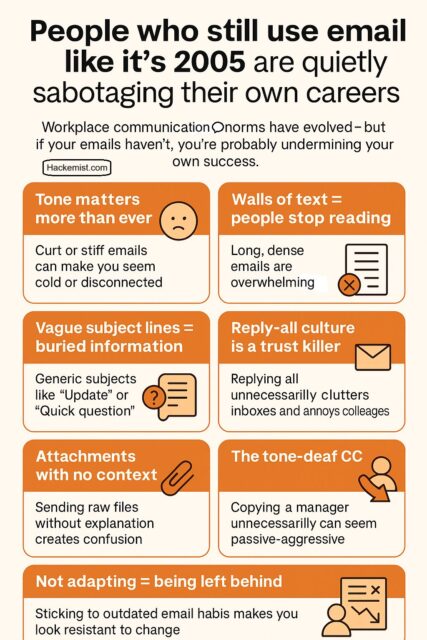Let me tell you about a guy I used to work with—let’s call him Martin.
Martin was smart, thoughtful, and good at his job. But he had one habit that quietly drove everyone up the wall: his emails felt like they were stuck in a time capsule from 2005. Walls of text. Vague subject lines. Random ALL CAPS for emphasis. He’d reply-all on every message, forget to include context, and his tone always felt just a little… off. Like he was either too formal or too cold. It was never malicious—it just didn’t evolve.
And over time, that started to matter more than he realized.
People stopped including him in high-stakes conversations. He was overlooked for leadership opportunities—not because he wasn’t capable, but because communication is often the lens through which we judge someone’s readiness to lead. And Martin’s emails made him look out of step, out of sync, and, frankly, out of date.
In today’s workplace, email isn’t just a tool. It’s a reputation. And if you’re still using it like it’s 2005, you might be quietly sabotaging your own career without even knowing it.
Here’s why—and what to do about it.
1. Tone matters more than ever—especially when you can’t rely on body language
Back in 2005, most workplaces still leaned on in-person meetings to smooth over awkward communication. You could send a clunky email and then explain yourself in the hallway or during a team huddle.
Not anymore.
Now, email is the meeting. It’s often the first impression, the follow-up, and the record. That means tone—how your message feels to the reader—is critical.
If your emails come off as curt, robotic, or passive-aggressive, people won’t always give you the benefit of the doubt. They’ll just assume that’s who you are.
On the flip side, if you’re still opening every message with “Dear Sir or Madam” or signing off with “Kind regards” in a thread about lunch options, you might come off as stiff or disconnected from the team culture.
Modern email tone is warm, direct, and human.
Think:
- “Hey team, quick heads up…”
- “Thanks again for jumping in on this.”
- “Appreciate your thoughts here—let me know what you think.”
It’s not casual to the point of unprofessionalism. But it’s conversational. That shift matters.
2. Walls of text = people stop reading
One of the biggest sins of the 2005 email style is the massive block of text.
No headers. No bullets. No breathing room.
It’s exhausting to read—and let’s be honest, most people won’t. They’ll skim. Or worse, they’ll avoid it completely and miss the point altogether.
If your message looks like a novel, even if it’s filled with brilliant insights, you’re putting the burden on the reader to do the sorting. That’s not a good look.
In 2025, good emailers do the mental lifting for their readers.
They break their messages down clearly:
- Use short paragraphs (1–3 lines).
- Add bullet points for clarity.
- Highlight action items.
- Use bold or headers (sparingly) to direct attention.
The easier your email is to read, the more authority and respect you’ll gain—not because your ideas are better, but because they’re easier to access.
3. Vague subject lines = buried information
The subject line is your headline. It tells the reader whether they need to open it now, later, or not at all. But in the 2005 email mindset, subject lines were often generic or recycled endlessly.
“Update”
“Quick question”
“Follow-up”
We’re beyond that now.
A good subject line tells you exactly what’s in the email and what it’s about. Think:
- “Q2 Client Report – Final Draft Attached”
- “Need feedback by Friday: new onboarding doc”
- “Next steps from Monday’s content meeting”
When you write clear subject lines, people know where to file the message mentally—and it increases the chance they’ll actually respond.
If you’re still being vague, you’re essentially hiding your own relevance.
4. Reply-all culture is a trust killer
In the early days of corporate email, reply-all was almost default. It was seen as efficient. Inclusive. Thorough.
Now? It’s a red flag.
People who reply-all without a clear reason are often seen as:
- Lacking awareness.
- Trying to signal competence rather than contribute meaningfully.
- Wasting other people’s time.
Respect for inboxes is modern workplace etiquette.
Before you reply-all, ask:
- Does everyone on this thread need to see this?
- Am I adding value for the group, or just responding out of habit?
If the answer is no, break the habit. Start replying just to the relevant people—and watch your professional reputation quietly rise.
5. Attachments with no context = digital chaos
You know what feels like a trap?
When someone sends an attachment titled “Final_version_(5)_EDITED” and the body of the email just says “Here it is.”
No intro. No summary. No context.
If you’re doing this, you’re creating more work for the recipient. You’re asking them to open the file, decipher what’s inside, and figure out what’s changed—all on their own.
In 2025, the best communicators don’t just send a file. They frame it.
Example:
Hi Maya,
Attached is the revised pitch deck with the updated case studies (slides 7–9). Let me know if you’d like any changes before Friday.
Thanks!
It’s 30 extra seconds of effort that saves the reader five minutes of confusion—and makes you look organized, thoughtful, and clear.
6. The tone-deaf cc: It still happens—and it still damages trust
Let’s say a coworker misses a deadline. Instead of checking in directly, you cc their manager on your “gentle reminder.”
That move? It hasn’t aged well.
In 2005, CCing a higher-up was a way to show accountability. Today, it often comes off as passive-aggressive escalation.
It tells the person: I don’t trust you to fix this, so I’m looping in someone who can hold you accountable.
That may be necessary in some cases, especially if a pattern is emerging. But if it’s your default? You’ll start losing trust faster than you build it.
Modern professionals deal directly, default to transparency, and loop in others only when it’s truly necessary.
7. Not adapting = being left behind
This is the deeper truth underneath all of this.
If your emails haven’t changed in 15 years, people start wondering what else about your work hasn’t evolved. Your tools? Your mindset? Your leadership?
It’s not fair. But it’s how perception works.
When your communication style feels dated, people assume your thinking might be, too. They may not say it out loud, but they’ll hesitate before giving you stretch assignments, leadership roles, or client-facing opportunities.
And in a hybrid or remote world where we rarely see each other face-to-face, your writing is your presence.
When it’s sharp, you seem sharp.
When it’s lazy, you seem lazy.
When it’s stuck in the past, you seem stuck in the past.
Final Thought: You don’t need to be perfect—just present
None of this is about becoming a flawless email robot.
It’s about being aware of how communication norms have changed—and how your habits are perceived. Because people aren’t just reading your messages. They’re reading into them.
They’re asking:
Is this person thoughtful?
Clear?
Adaptable?
Easy to work with?
Or are they still writing like it’s 2005?
You don’t need to master the latest productivity hacks or AI-powered inbox tools. But you do need to show that you’re here, paying attention, and willing to grow.
In today’s workplace, how you write is how you lead.
And if you’re still writing like it’s 2005, it might be time to hit “refresh”—before someone else hits “archive” on your influence.

